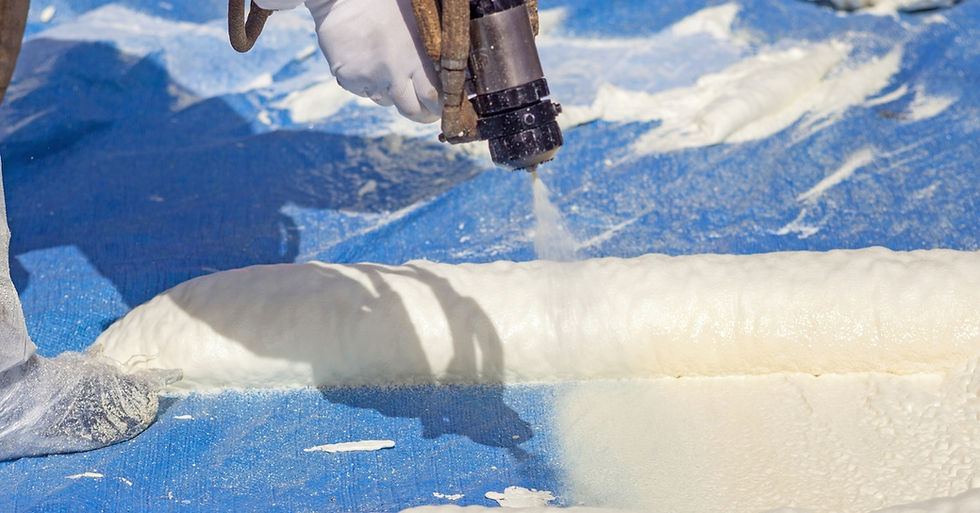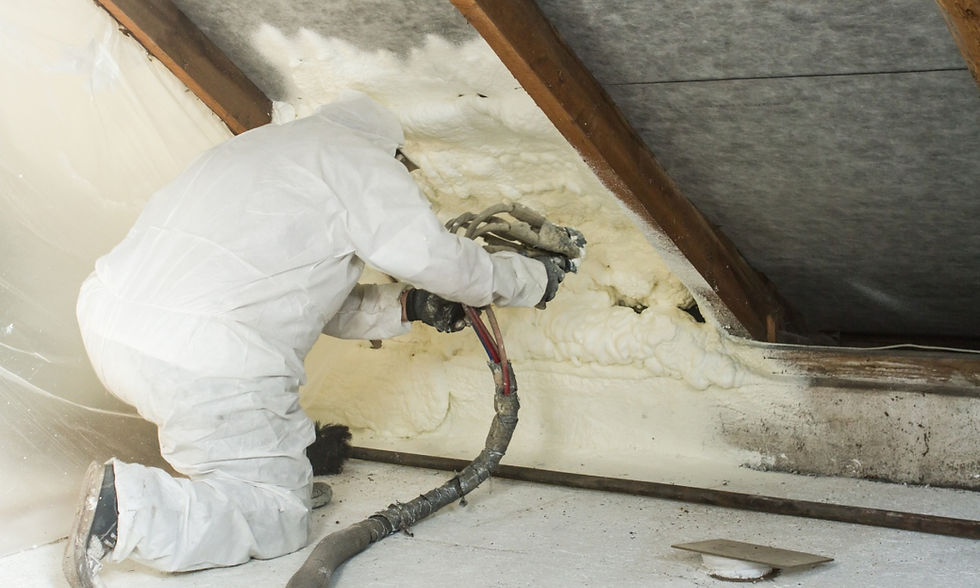Beginner’s Guide: Spray Foam Application Temperatures
- Jeromy Svec
- Aug 16, 2024
- 4 min read
Updated: Nov 25, 2024

Ensuring the right temperature during spray foam application can make or break your project. Spray foam insulation has revolutionized the construction industry. Its benefits include superior thermal insulation, moisture control, and structural strength.
But like any advanced material, it requires precise application techniques. One critical factor often overlooked is the temperature. Unravel the complexities of spray foam application temperatures with this beginner’s guide on spray foam application temperatures.
Why Temperature Matters in Spray Foam Application
Thermal Dynamics and Spray Foam
Temperature affects the chemical reaction in spray foam. It determines how well the foam expands, adheres, and cures. Too cold, and you risk poor adhesion and an uneven surface. Too hot, and the foam can overexpand or cure too quickly.
Preventing Costly Mistakes
Applying spray foam at the wrong temperature can lead to costly mistakes. Poor adhesion might require reapplication. Overexpansion can damage structures. Knowing the ideal temperature range can save you time and money.
Ensuring Safety
Temperature control isn't just about performance; it's about safety. Incorrect temperatures can cause off-gassing and other health hazards. Ensuring the right temperature protects both workers and building occupants.
The Ideal Temperature Range for Spray Foam
Ambient Temperature
The ambient temperature, or the temperature of the surrounding air, plays a crucial role. Typically, the ideal range falls between 60 °F and 90 °F. However, always refer to the manufacturer's guidelines for specific products.
Substrate Temperature
The substrate temperature, or the temperature of the surface being sprayed, should be within the same range as the ambient temperature. Cold substrates can cause condensation, affecting adhesion.
Material Temperature
The temperature of the spray foam material itself is equally important. Make sure to store drums or containers in a controlled environment. Using a drum heater can help maintain the right temperature.
Tools To Monitor and Control Temperature
Temperature Guns and Infrared Thermometers
Using a temperature gun or infrared thermometer allows you to monitor ambient and substrate temperatures accurately. These tools provide real-time data, helping you adjust conditions as needed.
Industrial Heaters
Industrial heaters can help maintain the right ambient temperature in colder environments. Choose heaters that can cover large areas and maintain consistent temperatures.
Drum Heaters and Warmers
Drum heaters and warmers ensure that the spray foam material is at the optimal temperature. Consistent heating prevents the foam from becoming too thick or too runny.
Seasonal Considerations for Spray Foam Application

Winter Applications
Winter poses unique challenges for spray foam application. Cold temperatures can cause the foam to thicken, making it harder to spray. Using industrial heaters and maintaining a warm storage area for materials is crucial.
Summer Applications
In summer, high temperatures can cause the foam to overexpand. This can lead to uneven surfaces and poor adhesion. Ensure proper ventilation and consider cooling the work area if temperatures soar.
Humidity Control
Humidity also affects spray foam application. High humidity can cause condensation on substrates, affecting adhesion. Dehumidifiers can help maintain the right moisture levels.
Best Practices for Temperature Control
Pre-Application Checks
Before starting, always check the temperature of the ambient air, substrate, and materials. Make adjustments as needed to ensure all are within the ideal range.
Continuous Monitoring
Throughout the application process, continuously monitor temperatures. Use temperature guns and thermometers to ensure conditions remain optimal.
Post-Application Care
After applying the spray foam, monitor the curing process. Ensure that temperatures remain stable to allow the foam to cure properly. Avoid sudden temperature changes that could affect the foam's integrity.
Troubleshooting Common Temperature Issues
Poor Adhesion
If the foam isn't sticking well, check the substrate temperature. It may be too cold or too damp. Warm the substrate and ensure it's dry before reapplying.
Uneven Expansion
Uneven expansion often indicates that the material temperature is off. Use drum heaters to bring the foam to the right temperature and try again.
Off-Gassing
Off-gassing can be a sign of overheating. Ensure that the ambient temperature is within the recommended range and improve ventilation.
The Role of Industrial Hoses in Temperature Control
Choosing the Right Hoses
Industrial hoses play a crucial role in spray foam application. They must withstand temperature fluctuations and maintain consistent material flow. Choosing the right hoses ensures even and effective foam application.
Maintenance and Care
Regular maintenance of industrial hoses is essential. Inspect them for wear and tear and replace them as needed. Clean hoses regularly to prevent blockages that could affect material flow.
Innovations in Hose Technology
Advancements in hose technology have led to more durable and efficient hoses. Investing in high-quality hoses found at The Handcrafted Hose Company can enhance your spray foam application process and ensure better results.
Troubleshooting Advanced Issues
Foam Shrinkage
Foam shrinkage can be a significant issue, leading to gaps and reduced insulation efficacy. This often arises from improper mixing or applying foam in temperatures that deviate from the ideal range. Calibrate your equipment and maintain the proper temperature throughout the process to avoid shrinkage.
Inconsistent Density
Inconsistent foam density can compromise structural integrity and insulation properties. This issue typically stems from fluctuations in application pressure or temperature inconsistencies. Regularly check your equipment settings and monitor environmental conditions to maintain uniform density.
Surface Defects
If you apply the foam too quickly or if environmental conditions are not conducive, bubbles, cratering, and other surface defects can occur. To prevent these defects, apply the foam in controlled layers, and allow each layer to cure adequately before proceeding.
Advanced Techniques in Spray Foam Application

Multi-Layer Application
Applying spray foam in multiple layers can significantly improve insulation performance and structural integrity. Allow each layer to expand and cure properly before adding subsequent layers. This technique is particularly effective in large-scale commercial projects.
Hybrid Insulation Systems
Combining spray foam with other insulation materials can yield superior results. Hybrid systems, such as using spray foam for air sealing and batts or blown-in insulation for additional R-value, offer versatility and enhanced thermal performance. Understanding when and how to use these combinations ensures optimized insulation.
Integrating With HVAC Systems
Proper integration of spray foam insulation with HVAC systems ensures that your building achieves maximum energy efficiency. Consult with HVAC professionals to design systems that complement spray foam insulation, preventing issues like ventilation blockages and ensuring efficient material distribution.
Understanding and controlling temperature is crucial for successful spray foam application. By following the best practices for spray foam application temperatures, you can achieve superior results and avoid common pitfalls.
Ready to take your spray foam application to the next level? Contact The Handcrafted Hose Company today for all your industrial hose needs. Our expert team is here to support you every step of the way.





